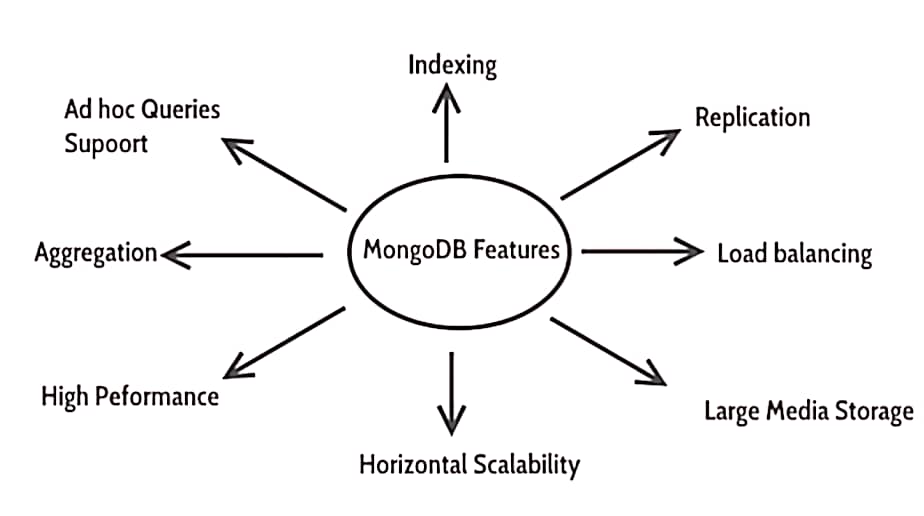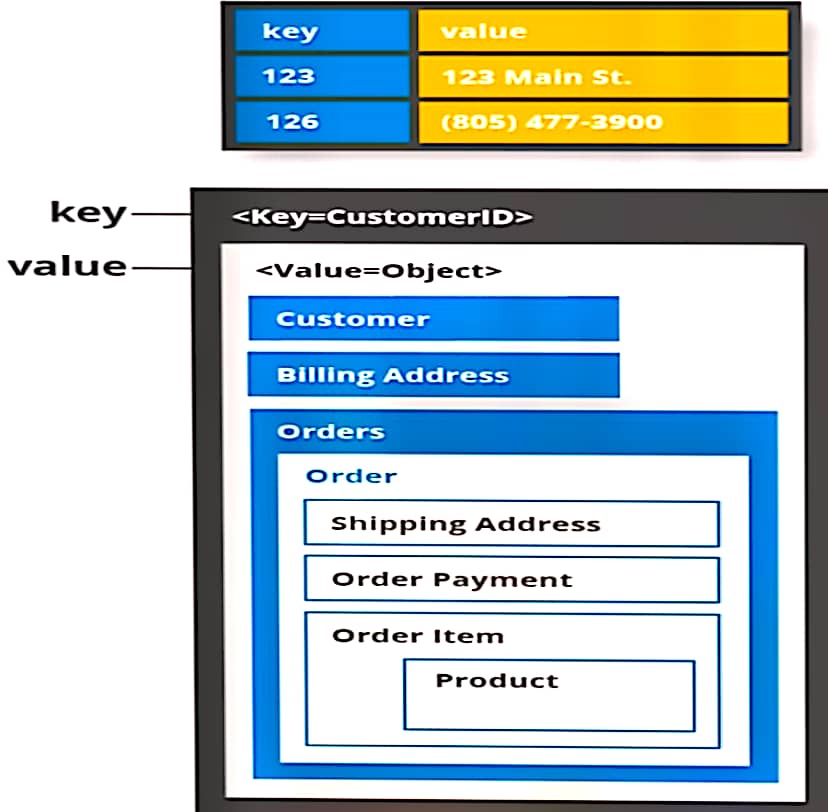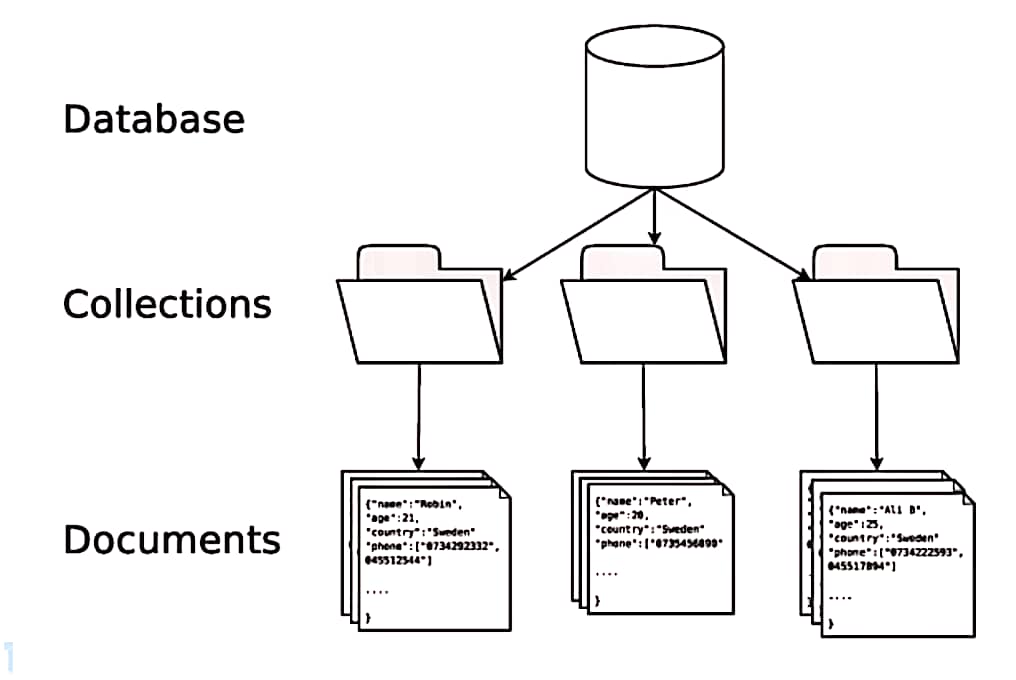MongoDB is a popular, open-source, NoSQL (Not Only SQL) database management system designed for storing, retrieving, and managing unstructured or semi-structured data.
Unlike traditional relational databases, MongoDB is a document-oriented database .
That uses a flexible and schema-less data model. It’s known for its scalability, high performance, and ease of use in handling large volumes of data and complex data structures.

Key Concepts in MongoDB
❖ Documents: MongoDB stores data in collections of documents. These documents are JSON-like objects and can have varying structures, making MongoDB highly flexible.
Each document can have its own set of fields and values.

❖ Collections: A collection in MongoDB is a group of related documents. Collections are roughly analogous to tables in relational databases.
❖ Fields: Fields within documents represent the data. They can contain various data types, including strings, numbers, arrays, and even other documents.
❖ Indexing: MongoDB supports indexing to improve query performance. You can create indexes on specific fields within documents to speed up searches.
❖ Queries: MongoDB provides a powerful query language for searching and retrieving data from the database
Example of MongoDB Document:
Let’s consider an example of a MongoDB document to understand how data is structured in MongoDB:
{
“_id”: ObjectId(“5f8c6c9e9a124503884b335d”),
“name”: “John Doe”,
“age”: 30,
“email”: “johndoe@example.com”,
“address”: { “street”: “123 Main Street”,
“city”: “Anytown”,
“state”: “CA”,
“zipcode”: “12345”
},
“interests”: [“hiking”, “photography”, “reading”]
}
In this example:
_id: Every MongoDB document has a unique _id field, which acts as the primary key. MongoDB automatically generates this unique identifier if you don’t specify one explicitly.
name, age, email: These fields hold simple data types like strings and numbers.
address: This field is an embedded document, which means it contains its own set of fields. The address field contains subfields like street, city, state, and zipcode.
interests: This field is an array that holds a list of values.
NoSQL Key/Value databases using MongoDB

NoSQL Key/Value databases using Mongo DB Key/Value databases are a type of NoSQL database that store and retrieve data using a simple key as the primary means of access
Key/Value Databases:
• In a Key/Value database:
• Data is stored as key-value pairs.
• Each key is unique and used to access its associated value.
• There is minimal structure or schema, and values can be simple or complex, including text, numbers, JSON objects, or even binary data.
Using MongoDB for Key/Value Storage:
While MongoDB is a document-oriented database, it can be used to implement a Key/Value storage pattern by utilizing a specific structure for documents.
You can store key-value pairs in MongoDB documents, where the key is the document’s field name, and the value is the field’s value.
Here’s an example:Consider a simple Key/Value use case for storing user settings:
Consider a simple Key/Value use case for storing user settings:
{
“_id”: ObjectId(“5f8c6c9e9a124503884b335d”),
// MongoDB’s unique identifier
“user_id”: “johndoe123”,
“settings”: {
“theme”: “dark”,
“notifications”: true,
“language”: “en-US”
V }
}
In this example:
• _id is MongoDB’s unique identifier.
• user_id is used as a key, uniquely identifying the user.
• settings is an embedded document that contains key-value pairs for various user settings.• To retrieve a user’s setting, you can query MongoDB using the user_id:
db.users.findOne({ user_id: “johndoe123” });
Document Databases
Document Databases A document database, also known as a document-oriented database, is a type of NoSQL database that is designed to store, retrieve, and manage semi-structured or unstructured data in the form of documents.

Each document is a self-contained unit of data and can contain a variety of information, including text, numbers, arrays, and even other nested documents.
Key characteristics of document databases:
1. Schema-less: Document databases are schema-less, meaning that each document in the database can have a different structure.
This flexibility is particularly useful when dealing with data that may evolve or change over time.
2. JSON or BSON: Documents are usually stored in formats like JSON (JavaScript Object Notation) or BSON (Binary JSON), making them easy to work with in modern programming languages.
3. Flexible Queries: Document databases typically support flexible querying and indexing, allowing you to search for documents based on the content within them.
4. Scalability: Many document databases are designed to be horizontally scalable, meaning they can handle large amounts of data and traffic by adding more servers or nodes to a cluster.
5. High Performance: They can offer high read and write performance, making them suitable for applications with dynamic, rapidly changing data.
Example of a Document Database:
Let’s consider a simple example using a hypothetical e-commerce platform. In a document database, you could store customer and order data in the following way:
{
“_id”: “customer123”,
“name”: “John Doe”,
“email”: “johndoe@email.com”,
“address”:{ “street”: “123 Main St”, “city”: “Anytown”, “zip”: “12345”
}
}
In this example, each customer is represented as a JSON document. The document contains key-value pairs where “name,” “email,” and “address” are fields with corresponding values. The “address” field, in turn, contains nested data.Now, let’s consider an order document:
{
“_id”: “order456”,
“customer_id”: “customer123”,
“order_date”: “2023-10-16”,
“products”: [
{
“product_id”: “prod789”,
“quantity”: 2
},
{
“product_id”: “prod456”,
“quantity”: 1
}
]
}
Document oriented Database Features
Document-oriented databases have several features that make them well-suited for certain types of applications.
Here are some key features of document-oriented databases, along with examples to illustrate each feature:
Schema Flexibility:
Feature: Document databases are schema-less, meaning each document can have a different structure. You don’t need to define a fixed schema in advance.
Nested Documents:Feature: Document databases support nested documents, allowing you to embed one document within another.
JSON/BSON Format:Feature: Documents are typically stored in JSON or BSON formats, making it easy for developers to work with the data.
High Performance:Feature: Document databases can provide high read and write performance due to their flexible structure and efficient indexing.
Flexible Queries:Document databases offer flexible query capabilities, allowing you to search for documents based on the content within them.
Automatic Sharding:Feature: Many document databases support automatic sharding, which allows them to distribute data across multiple servers to handle large datasets and high traffic.
Horizontal Scalability:Feature: Document databases can be horizontally scaled by adding more servers or nodes to a cluster, making them suitable for applications with increasing data and user loads.
Consistency and Availability Trade-offs:Feature: Document databases often provide options for adjusting consistency and availability to meet specific application requirements
OTHER COURSES : Cloud computing

Leave a Reply